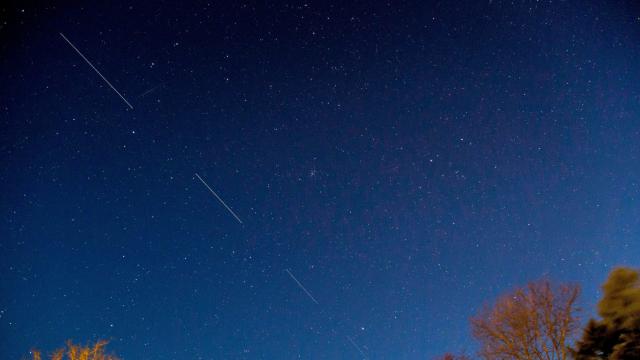Elon Musk’s dream of an Earth surrounded by teaming clouds of Low Earth Orbiting satellites, a project known as Starlink, just happens to be a nightmare for astronomers and amateur stargazers alike. A new report on the many challenges Starlink poses suggests astronomers’ best-case scenario is for SpaceX to abandon the project.
The Satellite Constellations 1, or Satcon1 workshop brought together 250 astronomers, engineers, commercial satellite operators, and other stakeholders and was organised by the National Science Foundation’s NOIRLab and the American Astronomical Society. Satcon1’s mission was to investigate problems with, you guessed it Satellite Constellations, namely the Starlink project.
Satellite Constellations are satellites that work together to provide continuous coverage to a certain part of the Earth. The Global Positioning System works in this manner. Starlink started as a network of 60 satellites a little over a year ago is now 538 units strong, according to TechCrunch. Their purpose, someday, will be to provide high-speed internet to everyone on the planet. The company says it needs to get to least 800 satellites to be operational, but plan on at least 12,000.
The American Astronomical Society spells out what is at stake in its press release on the workshop:
When SpaceX launched its first batch of 60 Starlink communication satellites in May 2019 and people all over the world saw them in the sky, astronomers reacted with alarm. Not only were the Starlink satellites brighter than anyone expected, but there could be tens of thousands more like them. As they pass through Rubin’s camera field, they will affect the 8.4-metre telescope’s view of the faint celestial objects astronomers hope to study with it.
“Rubin Observatory and the giant 30-metre telescopes coming online in the next decade will substantially enhance humankind’s understanding of the cosmos,” says SATCON1 co-chair Jeff Hall from Lowell Observatory and chair of the AAS Committee on Light Pollution, Radio Interference, and Space Debris. “For reasons of expense, maintenance, and instrumentation, such facilities cannot be operated from space. Ground-based astronomy is, and will remain, vital and relevant.”
Astronomer Julien Giard from the Space Telescope Science Institute highlighted an image taken by astrophotographer Daniel López that shows just how intrusive the satellites can be:
17 30-second images of the comet added up by @cielodecanarias, completely photobombed by @elonmusk‘s #Starlink satellites. It’s a few hundreds of them right now,there will be a few thousands in the near future. @SpaceX is committed to coating orienting them better but still…. pic.twitter.com/TYtTf5xwhc
— Julien Girard (@djulik) July 22, 2020
The findings of the workshop were tough. While scientists are the first people to agree that widespread access to high-speed internet is a worthy goal, they found that such valuable scientific activities as “…searches for Earth-threatening asteroids and comets, outer solar system objects, and visible-light counterparts of fleeting gravitational-wave sources” would be affected. Here are their six solutions to the problem:
- Launch fewer or no LEOsats. However impractical or unlikely, this is the only option identified that can achieve zero astronomical impact.
- Deploy satellites at orbital altitudes no higher than ~600 km.
- Darken satellites or use sunshades to shadow their reflective surfaces.
- Control each satellite’s orientation in space to reflect less sunlight to Earth.
- Minimise or eventually be able to eliminate the effect of satellite trails during the processing of astronomical images.
- Make more accurate orbital information available for satellites so that observers can avoid pointing telescopes at them.
Currently, SpaceX is experimenting with sun visors that would dim the unusually bright objects, though the visors are only to deployed on 58 of the over 500 currently in orbit. There is a Satcon2 planned for mid-2021 to hammer out possible policy and regulation recommendations. NOIRLab director Patrick McCarthy said in the press release that hopefully, science and industry can work together:
“I hope that the collegiality and spirit of partnership between astronomers and commercial satellite operators will expand to include more members of both communities and that it will continue to prove useful and productive. I also hope that the findings and recommendations in the SATCON1 report will serve as guidelines for observatories and satellite operators alike as we work towards a more detailed understanding of the impacts and mitigations and we learn to share the sky, one of nature’s priceless treasures.”
